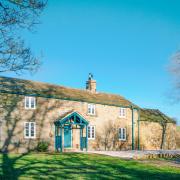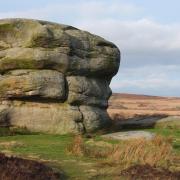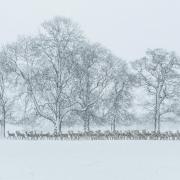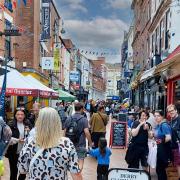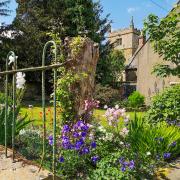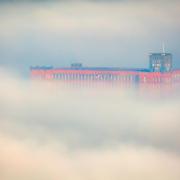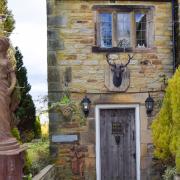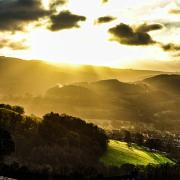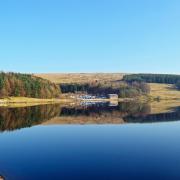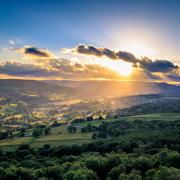Mike Smith explores one of our county’s most historic and iconic stately homes
The astonishing appearance of Bess of Hardwick’s great Derbyshire country house, which is one of England’s most popular National Trust properties, is best summed up in the well-known rhyme: ‘Hardwick Hall, more glass than wall’.
All three storeys of the stately home are almost entirely dominated by windows, which grow in size as the building soars upwards.
This unique hall was designed by Robert Smythson, who was the first master stonemason in England to be recognised as an ‘architect’.
He was responsible for the planning of some of the country’s greatest country houses, including Longleat and Wollaton Hall. But it is Hardwick Hall, built between 1590 and 1597, that is recognised as the high point of Elizabethan architecture.
The building is topped by towers decorated with the carved initials E.S. (Elizabeth Shrewsbury). This ostentatious display was clearly designed by Bess to boast that she had become one of the most influential and wealthiest women in England.
Well-made marriages
Much of Bess’ fortune was made through a series of well-made marriages. Her first husband was 15-year-old Robert Barlow, heir to a neighbouring estate, who died when he was still a teenager.
Her second husband was Sir William Cavendish, who was twice her age and, as Treasurer of the King’s Chamber, had accumulated his wealth through the dissolution of the monasteries.
After his death, Bess married Sir William St Loe, Captain of the Guard to Queen Elizabeth I and the owner of several estates, which he left to Bess when he died.
Her fourth husband was George Talbot, the sixth Earl of Shrewsbury, one of the premier aristocrats of England and the custodian of Mary Queen of Scots.
On George’s death in 1590, Bess, who had always been an obsessive builder of houses, used her inherited wealth to construct a great new hall on a plot of land adjacent to the original Hardwick Hall, which still survives as a romantic ruin. In his plans for the new house, Smythson incorporated many of the ideas Bess had pioneered in extensions she had made to the old Hardwick Hall.

Status symbols
One of the many unusual aspects of Hardwick’s interior is the double-height entrance hall, which is placed centrally and runs from the front to the back of the building.
The elaborate coat-of-arms on the overmantel is another feature designed by Bess to emphasise her status.
Doric columns support what looks like a minstrel’s gallery but is actually a landing built to connect her apartments on the first floor.
A stone staircase, made deliberately much wider than was necessary, forms a processional route that was designed to impress Bess’ guests on their approach to the state rooms.
Their expectations were more than satisfied when they arrived at the High Great Presence Chamber, described by Sir Sacheverell Sitwell as ‘the most beautiful room, not in England alone, but in the whole of Europe’.

It features fabulous tapestries, large windows, an impressive chimney-piece and, as its pièce de résistance, a huge plaster-work frieze depicting forest and hunting scenes, which include exotic animals discovered during early expeditions to far-off lands.
The centrepiece of the frieze is a representation of the Goddess Diana surrounded by her court, with three stags protecting her from wild animals.
Most experts believe that the panel is actually a homage to Queen Elizabeth I and that the stags, copied from the Cavendish coat-of-arms, express allegiance to the monarch shown by Bess, who would have dearly loved the Queen to visit Hardwick. Elizabeth never came, possibly because she was reluctant to travel so far from London.
The second great state room, situated on the top floor, is the fantastic Long Gallery, which occupies the entire east front. At 50 metres in length and eight metres in height, it is the largest surviving Elizabethan gallery in England.
The room is sumptuously decorated with a large collection of original paintings and with the Gideon Tapestries, the most famous of the many tapestries that are such a magnificent feature of this wonderful treasure house.
WHILST YOU ARE THERE
An important part of the Hardwick experience for visitors is the beautifully restored 400-year-old stable yard, which includes The Great Barn Restaurant, with seating areas on two levels, supplemented by outside seating, a National Trust shop, a plant shop and a second-hand book shop with a wood-burning stove to give extra atmosphere and browsing comfort.
You may also want to sample one or more of the further attractions that are located in and around the estate:

Hardwick Old Hall
Hardwick Old Hall was extended and developed by Bess before she became wealthy enough to build a new hall on an adjacent plot of land.
Many of the surviving features in the gaunt ruins, now cared for by English Heritage, were prototypes for those found in the new hall. They include elaborate plaster-work and the type of very large windows that are so prominent in the new house.

Hardwick Park
The park provides perfect opportunities for woodland walks and for enjoying spectacular views across picturesque former mill ponds towards a wooded hillside, topped by the two Hardwick Halls.

The Hardwick Inn
The 16th century Hardwick Inn is described in Derry Brabbs’ book of English Country Pubs, as ‘having many rooms which feel like those of a private country house, decorated with elegant wallpaper and lit by daylight filtering through mullioned lattice windows’. The bar has 200 varieties of malt whisky.

Stainsby Mill
Stainsby Mill provided flour for the Hardwick Estate and local villages.
Volunteers at the restored building explain the entire process from the growing of wheat to the putting of flour into bags that are available for purchase. Visitors can even have a go at grinding their own flour.

Ault Hucknall
Although Ault Hucknall claims to be England’s smallest village, it contains a charming house that could easily pass as a Cotswolds’ cottage, as well as a grand church, which features both a tiny window covered by an arch that looks like a coiled rope and a very ancient tympanum.




